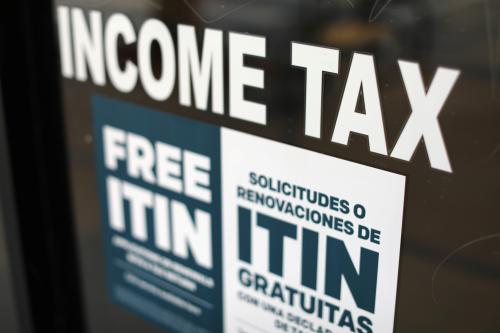This article originally appeared on Real Clear Markets on October 20, 2017.
In a speech earlier this week, Donald Trump invoked Ronald Reagan’s 1981 tax cuts as a model for his own plan. Trump said Reagan’s tax cuts “unleashed the economic miracle of the 1980s” and promised his own tax cuts would boost economic growth substantially. Consider those statements “alternative facts.”
In principle, well-designed tax cuts can increase economic activity since lower marginal tax rates boost the reward for firms that invest and hire and for people who work and save more. But there is another part of the story: Lower rates also reduce the need for people to work and save more to achieve a desired living standard. And if tax rate cuts are not offset by other tax increases or spending cuts, they’ll require higher government borrowing. Those effects discourage future economic growth.
The Unified Framework developed by the White House and congressional Republicans contains some pro-growth elements, such as expensing—immediate write-offs for the full cost of new investments in equipment. But many aspects of the plan will stunt growth. The cut in corporate tax rates, for example, loses a substantial amount of revenue, which will raise deficits. It provides windfall subsidies to the returns that companies are getting now for investments they made in the past. That does nothing to stimulate growth – you can’t boost past investment.
Perhaps surprisingly, the cut in corporate tax rates also does nothing to stimulate new investment in equipment, once expensing is in place. With expensing, the effective marginal tax rate on new investment does not fall even if the statutory rate does. The reason is that companies can immediately write off the cost of new investment, kind of like a contribution to an IRA or 401(k). Any future tax simply represents the returns on the up-front deduction. The net of tax investment grows tax-free, and that’s true whether the tax rate is 20 or 35 percent.
The plan would also move the U.S. toward a territorial tax system, under which U.S. companies would pay no U.S. taxes on their foreign income. That would encourage them to ship jobs, capital, and profits overseas. Thus, Trump’s tax cuts would most likely continue the long trend of deficit-financed tax cuts having small or negative effects on long-term growth.
Trump’s tax cuts would most likely continue the long trend of deficit-financed tax cuts having small or negative effects on long-term growth.
Since Trump invoked Reagan, whose 1981 plan reduced top individual income tax rates by 20 points, let’s start there. The economy did, in fact, grow robustly in the years following the tax cut. But the vast majority of this growth, according to President Reagan’s former chief economist, Martin Feldstein, was due to expansive monetary policy that slashed interest rates massively and helped the economy bounce back from a severe recession after 1982. In addition, a defense buildup boosted spending, and an influx of baby boomers (who were between 17 and 35 years old in 1981) and women expanded the labor force. In a separate study, Feldstein and former Congressional Budget Office Director Doug Elmendorf found no evidence that the 1981 tax cuts got people to work more.
The Bush tax cuts in 2001 and 2003 paint a similar picture. Between 2001 and 2007 (before the financial crisis and Great Recession), the economy grew at a lackluster pace—real per-capita income rose by 1.5 percent annually, compared to 2.3 percent from 1950 to 2001. Gains were concentrated in housing and finance, two sectors that were not favored by the 2001 and 2003 tax cuts. By 2006, prime-age males were working the same amount they were in 2000—before the tax cuts—and women were working less, inconsistent with the view that lower tax rates raise labor supply.
If tax cuts boost growth, tax increases should stall the economy. But, while Bill Clinton’s tax increase in 1993 didn’t cause the economic boom that followed, the experience shows that higher levies on high-income households need not interfere with faster economic growth.
More recently, several states experimented with tax cuts with little obvious success. The most notorious case is Kansas, where Governor Sam Brownback promised that a moderate tax cut for individuals and a big tax cut for businesses would be “like a shot of adrenaline into the heart of the Kansas economy.” Since the 2012 tax cut, however, Kansas’s economy has lagged behind neighboring states, and the state’s budget has been in tatters. Earlier this year, in the face of poor growth and spending needs, the Republican-led state legislature reversed much of Brownback’s original tax cut. Reams of evidence from other states are equally unsupportive of the supply-side notion that tax cuts boost growth.
Nor does the international evidence offer any respite. Research shows little correlation between how countries change their top income tax rate and how much their economies grow.
Despite the evidence, the Administration and the Congress continue to vastly overstate the prospects for potential growth from their tax cuts. Treasury Secretary Steven Mnuchin has said several times that the President’s proposed tax cuts would raise growth by so much that they would be self-financing.
Few economists outside the Administration not named Arthur Laffer agree, including none of the leading economists who responded to a recent University of Chicago survey.
So why does the pursuit of tax cuts in the name of growth persist? Maybe it’s the triumph of ideology over evidence, naïve wishful thinking ,or the desire to tell people what they want to hear. Or maybe, it’s the temptation to take the easy way out. After all, enacting supposedly self-financing tax cuts would indeed be much easier than facing the tradeoffs—and hard choices—that budget realists know policymakers must eventually address.
Growth is clearly a priority, and there are many ways to achieve it. Evidence indicates that investing in infrastructure or offering people better education, health, and housing can boost long-term growth prospects. Deficit-financed tax cuts, on the other hand, just won’t get the job done.
The Brookings Institution is committed to quality, independence, and impact.
We are supported by a diverse array of funders. In line with our values and policies, each Brookings publication represents the sole views of its author(s).





Commentary
Op-edWhy tax cuts will not make America great again
October 20, 2017